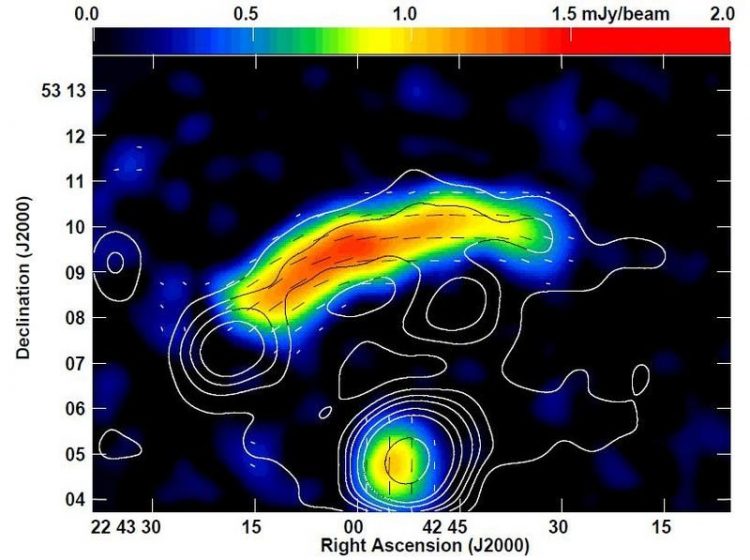Giant Magnetic Fields in the Universe

Radio map of the relic at the outskirts of the galaxy cluster CIZA J2242+53 in a distance of about two billion light years, observed with the Effelberg radio telescope at 3 cm wavelength Maja Kierdorf et al., 2017, A&A 600, A18
Galaxy clusters are the largest gravitationally bound structures in the universe. With a typical extent of about 10 million light years, i.e. 100 times the diameter of the Milky Way, they host a large number of such stellar systems, along with hot gas, magnetic fields, charged particles, embedded in large haloes of dark matter, the composition of which is unknown.
Collision of galaxy clusters leads to a shock compression of the hot cluster gas and of the magnetic fields. The resulting arc-like features are called “relics” and stand out by their radio and X-ray emission. Since their discovery in 1970 with a radio telescope near Cambridge/UK, relics were found in about 70 galaxy clusters so far, but many more are likely to exist. They are messengers of huge gas flows that continuously shape the structure of the universe.
Radio waves are excellent tracers of relics. The compression of magnetic fields orders the field lines, which also affects the emitted radio waves. More precisely, the emission becomes linearly polarized. This effect was detected in four galaxy clusters by a team of researchers at the Max Planck Institute for Radio Astronomy in Bonn (MPIfR), the Argelander Institute for Radio Astronomy at the University of Bonn (AIfA), the Thuringia State Observatory at Tautenburg (TLS), and colleagues in Cambridge/USA.
They used the MPIfR’s 100-m radio telescope near Bad Münstereifel-Effelsberg in the Eifel hills at wavelengths of 3 cm and 6 cm. Such short wavelengths are advantageous because the polarized emission is not diminished when passing through the galaxy cluster and our Milky Way. Fig.1 shows the most spectacular case.
Linearly polarized relics were found in the four galaxy clusters observed, in one case for the first time. The magnetic fields are of similar strength as in our Milky Way, while the measured degrees of polarization of up to 50% are exceptionally high, indicating that the emission originates in an extremely ordered magnetic field. “We discovered the so far largest ordered magnetic fields in the universe, extending over 5-6 million light years”, says Maja Kierdorf from MPIfR Bonn, the project leader and first author of the publication.
She also wrote her Master Thesis at Bonn University on this subject. For this project, co-author Matthias Hoeft from TLS Tautenburg developed a method that permits to determine the “Mach number”, i.e. the ratio of the relative velocity between the colliding gas clouds and the local sound speed, using the observed degree of polarization. The resulting Mach numbers of about two tell us that the galaxy clusters collide with velocities of about 2000 km/s, which is faster than previously derived from measurements of the X-ray emission.
The new Effelsberg telescope observations show that the polarization plane of the radio emission from the relics turns with wavelength. This “Faraday rotation effect”, named after the English physicist Michael Faraday, indicates that ordered magnetic fields also exist between the clusters and, together with hot gas, cause the rotation of the polarization plane. Such magnetic fields may be even larger than the clusters themselves.
„The Effelsberg radio telescope proved again to be an ideal instrument to detect magnetic fields in the universe“, emphasizes co-author Rainer Beck from MPIfR who works on this topic for more than 40 years. “Now we can systematically search for ordered magnetic fields in galaxy clusters using polarized radio waves.”
The research team comprises of Maja Kierdorf, Rainer Beck, Matthias Hoeft, Uli Klein, Reinout van Weeren, William Forman, and Christine Jones. First author Maja Kierdorf and Rainer Beck are MPIfR employees.
Original publication:
Relics in galaxy clusters at high radio frequencies, M. Kierdorf, R. Beck, M. Hoeft, U. Klein, R. J. van Weeren, W. R. Forman, and C. Jones, 2017, Astronomy & Astrophysics 600, A18 (March 22, 2017): https://doi.org/10.1051/0004-6361/201629570
Contact:
Maja Kierdorf,
Max-Planck-Institut für Radioastronomie, Bonn.
Phone: +49 228 525-180
E-mail: kierdorf@mpifr-bonn.mpg.de
Dr. Rainer Beck,
Max-Planck-Institut für Radioastronomie, Bonn
Phone: +49 6221 528-323
E-mail: rbeck@mpifr-bonn.mpg.de
Dr. Norbert Junkes,
Press and Public Outreach
Max-Planck-Institut für Radioastronomie, Bonn.
Phone: +49 228 525-399
E-mail: njunkes@mpifr-bonn.mpg.de
Media Contact
All latest news from the category: Physics and Astronomy
This area deals with the fundamental laws and building blocks of nature and how they interact, the properties and the behavior of matter, and research into space and time and their structures.
innovations-report provides in-depth reports and articles on subjects such as astrophysics, laser technologies, nuclear, quantum, particle and solid-state physics, nanotechnologies, planetary research and findings (Mars, Venus) and developments related to the Hubble Telescope.
Newest articles

First-of-its-kind study uses remote sensing to monitor plastic debris in rivers and lakes
Remote sensing creates a cost-effective solution to monitoring plastic pollution. A first-of-its-kind study from researchers at the University of Minnesota Twin Cities shows how remote sensing can help monitor and…

Laser-based artificial neuron mimics nerve cell functions at lightning speed
With a processing speed a billion times faster than nature, chip-based laser neuron could help advance AI tasks such as pattern recognition and sequence prediction. Researchers have developed a laser-based…

Optimising the processing of plastic waste
Just one look in the yellow bin reveals a colourful jumble of different types of plastic. However, the purer and more uniform plastic waste is, the easier it is to…


